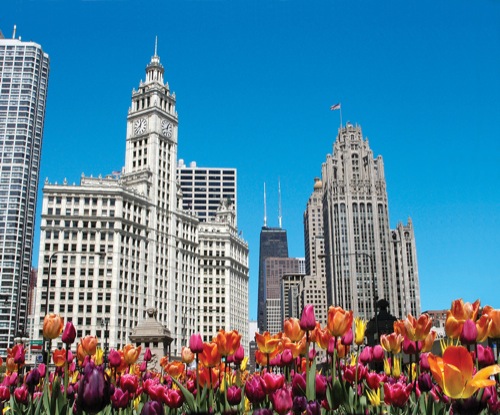
Courtesy Choose Chicago
Michigan Avenue
Chicago
The gateway to the Magnificent Mile, which runs from the Chicago River to Oak Street, is the bridge over the river, which gives a great view of the white terra-cotta Wrigley Building and the Chicago Tribune Tower with its Gothic top and stone from famous buildings around the world embedded in its foundation.
At the other end, the Drake Hotel’s second-floor restaurant, which serves high tea in the afternoon, has a great view of Lake Michigan.
In between are numerous upscale shops and a great variety of restaurants, with gardens in front of many of the buildings filling the street from spring through fall with a rainbow of colors.
The owners and tenants are responsible for the gardens in front of their buildings, and competition for the most beautiful garden has prompted great landscaping.
“The Magnificent Mile is urban development with gardens, theater, shopping, learning establishments. It is totally free to experience the Magnificent Mile — if you don’t buy anything,” said Holly Agra, president and owner of Chicago’s First Lady Tours, whose tour boats depart from beneath the Chicago River bridge.
Several hundred of the stores along Michigan Avenue, including Macy’s, Saks, Lord and Taylor, and Nordstrom, are in four vertical shopping malls.
Also along Michigan Avenue’s Magnificent Mile are the limestone Water Tower and the Pump Station, the only two buildings left after the Chicago fire of 1871. The Pump Station is home to the Lookingglass Theatre, which received the 2011 Tony Award for regional theater.
The John Hancock Observatory is also along Michigan Avenue. Its 94th-floor observation deck provides sweeping views of Lake Michigan and the north end of Chicago and features a European-style coffee shop that provides great views of the sunset.
www.gnmaa.com
www.choosechicago.com
Woodward Avenue
Detroit
Woodward Avenue, which has been designated a National Scenic Byway and an All-American Road, runs for 27 miles from downtown Detroit to Pontiac, Mich. “It goes through 11 diverse and eclectic communities and cities,” said Lori Ella Miller, marketing and communications manager for the Woodward Avenue Action Association.
Woodward Avenue played a major role in the development of the automobile industry. In 1909, Henry Ford built a massive factory complex on Woodward Avenue in Highland Park, where workers, who were paid the then unheard of sum of $5 per day, turned out Model Ts on the world’s first moving assembly line.
“It still stands, and it will be on the new In the Steps of Henry Ford group tour we are developing,” said Miller.
The world’s first mile of paved concrete road was on Woodward Avenue, also in 1909, and the world’s first electric traffic light was at Woodward and Michigan avenues in 1920.
Cars still play a major role on Woodward Avenue with the annual Woodward Dream Cruise on a 16-mile stretch between Pontiac and Ferndale, which draws 40,000 classic cars and more than 1.5 million people on the third Saturday in August each year (Aug. 18, 2012).
Many of Detroit’s major attractions, such as the Detroit Institute of Arts, the Detroit Historical Museum, the Fox Theatre, the Detroit Zoo, Comerica Park and Ford Field, are located along the avenue.
In addition to classic cars, Woodward Avenue is the scene of Detroit’s large annual Thanksgiving Day parade, and the Michigan State Fair has been held at the fairgrounds on Woodward Avenue since 1849.
www.woodwardavenue.org
Beale Street
Memphis, Tenn.
Music defines Memphis.
“Our biggest hook is music. That’s what people around the world know most about Memphis,” said Regena Bearden, vice president of marketing and public relations for the Memphis Convention and Visitors Bureau.
“No other city has been so pivotal in the history of American music,” wrote Bill Wyman in “Rolling With the Stones.”
And no place epitomizes Memphis music more than Beale Street, which has an eclectic mix of restaurants, shops and nightspots where there is a wide choice of live music nightly.
“It is nonstop music there,” said Bearden.
“You can always find live blues, jazz, rock, R&B, soul and gospel music performed live,” said Jonathon Lyons, public relations manager for the CVB.
Although the new FedEx Forum has become the center of major concerts on Beale Street, Lyons said there are still “classic smaller venues that still have A-list music performers coming through.”
Mr. Handy’s Blues Hall and Handy Park, a venue for outdoor concerts, are named for W.C. Handy, considered the Father of the Blues, who wrote several seminal blues songs such as “Beale Street Blues” and “Memphis Blues” while living on Beale Street. Handy’s small house is filled with artifacts and memorabilia and is open to the public.
Also on Beale Street is the Rock and Soul Museum, which explores all aspects of Memphis’ musical heritage.
The Riverside Grill and Dockside Bar is scheduled to open this summer at the new Beale Street Landing at the foot of Beale Street on the Mississippi River.
“The food will be a taste of Memphis, with ribs, barbecue and catfish,” said Lyons. “It will have some of the best views of the downtown skyline that people have not been able to experience before in a restaurant and bar.”











